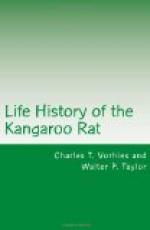When watching beside a mound by moonlight one is impressed with the fact that the rats possess either a very keen sense of hearing or of sight, probably both. The very slightest movement or noise on the part of the observer results, with a timid individual, in an instantaneous leap for safety, a disappearance into the burrow so sudden as to be almost startling. All attempts to obtain flashlight photographs at the mounds were failures, the animal either having gotten completely out of the field before the light flashed following the pull of the trigger, or leaving merely an indistinguishable blur on the plate as it went, and this in spite of carefully hiding the trigger chain behind a screen. A slight noise accompanying the trigger action gave the alarm in one case, and in another the length of time of the flash was sufficient for the get-away. The marvelous quickness of the animal clearly indicates a remarkably short reaction time. Occasionally a bold individual is found, as in the case of one which came out repeatedly, even after being flashed twice in the same night.
Certain peculiar physical characteristics suggest a relationship to sense reactions. On these, however, the authors are not prepared to do more than offer suggestions for future work. The extremely large mastoids found in kangaroo rats suggest a connection in some way with special developments of the sense of hearing or of balance. It may be noted that an intermediate condition between the kangaroo rats and the majority of rodents in respect to this character is to be found in the pocket mice (Perognathus), which belong to the same family. Herein lies a field for some interesting experimentation and discovery.
The small, pointed nose might suggest a not overkeen sense of smell, and there appears no reason to believe that this sense is particularly well developed. However, the turbinals are very complex. The vibrissae are long and sensitive, and may indicate a special development of the sense of touch as an adaptation to nocturnal habits and to life in an underground labyrinth. The long, well-haired tail doubtless serves as an important tactile organ as well as a balance.
MOVEMENTS AND ATTITUDES.
Movements and attitudes are characteristic. As a kangaroo rat emerges from the burrow a reason for the relatively large size of the opening is seen in the fact that, kangaroolike, the animal maintains a partially upright position. Its ordinary mode of progression is hopping along on the large hind legs, or, when in the open and going at speed, leaping. When moving slowly about over the mound, as if searching for food, it uses the fore legs in a kind of creeping movement. It appears to be creeping when pocketing grain strewn about, but close observation shows that the fore feet are then used for sweeping material into the pockets, reminding one somewhat of a vacuum cleaner.




